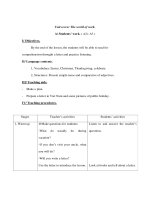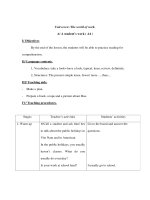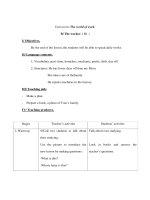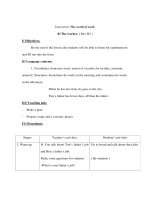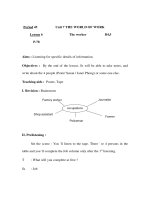The world of psychology 7th canadian edition samuel e wood
Bạn đang xem bản rút gọn của tài liệu. Xem và tải ngay bản đầy đủ của tài liệu tại đây (24.92 MB, 529 trang )
Samuel e. Wood
ellen Green Wood
deniSe Boyd
eileen Wood
the World of
SerGe deSmaraiS
Psych
ology
7th Canadian edition
Toronto
Toronto
Vice-President, Editorial Director: Gary Bennett
Editor-in-Chief: Michelle Sartor
Acquisitions Editor: Matthew Christian
Marketing Manager: Lisa Gillis
Senior Developmental Editor: Patti Altridge
Project Manager: Jessica Hellen
Manufacturing Specialist: Jane Schell
Production Editor: Katie Ostler, Element LLC
Copy Editor: Stephanie Fysh
Proofreaders: Maria Jelinek, Tara Tovell
Compositor: Element LLC
Photo and Permissions Researcher: Tara Smith
Art Director: Miguel Acevedo
Cover and Interior Designer: Opus House / Sonya Thursby
Cover Image: Clive Branson/Wildcard Images, UK
Credits and acknowledgments of material borrowed from other sources and reproduced, with permission,
in this textbook appear on the appropriate page within the text and on p. 495.
Original edition published by Pearson Education, Inc., Upper Saddle River, New Jersey, USA. Copyright
© 2011 Pearson Education, Inc. This edition is authorized for sale only in Canada.
If you purchased this book outside the United States or Canada, you should be aware that it has been
imported without the approval of the publisher or author.
Copyright © 2014, 2011, 2008, 2005, 2002, 1999, 1996 Pearson Canada Inc. All rights reserved.
Manufactured in the United States of America. This publication is protected by copyright and permission
should be obtained from the publisher prior to any prohibited reproduction, storage in a retrieval system,
or transmission in any form or by any means, electronic, mechanical, photocopying, recording, or likewise.
To obtain permission(s) to use material from this work, please submit a written request to Pearson Canada
Inc., Permissions Department, 26 Prince Andrew Place, Don Mills, Ontario, M3C 2T8, or fax your request to
416-447-3126, or submit a request to Permissions Requests at www.pearsoncanada.ca.
10 9 8 7 6 5 4 3 2 1 [CKV]
Library and Archives Canada Cataloguing in Publication
The world of psychology / Samuel E. Wood . . . [et al.]. — 7th
Canadian ed.
Includes bibliographical references and indexes.
ISBN 978-0-205-19711-8
1. Psychology—Textbooks. I. Wood, Samuel E
BF121.W67 2013
150
C2012-904918-2
ISBN 978-0-205-19711-8
Brief Contents
1 Introduction to Psychology
2 Biology and Behaviour
3 Sensation and Perception
4 States of Consciousness
5 Learning
125
6 Memory
155
7 Cognition, Language, and Intelligence
8 Development
9 Motivation and Emotion
3
29
61
97
219
249
10 Social Psychology
11 Personality Theory and Assessment
12 Health and Stress
13 Psychological Disorders
14 Therapies
277
335
385
Gl ossa ry 410
Ref e re n ces 426
Name In de x 474
Sub j ect In de x 484
c redits 495
185
357
307
Contents
Boxes xvii
An Invitation to the Student xxi
Preface xxv
Acknowledgments xxix
About the Authors xxxi
CHAPTER 1 Introduction to Psychology 3
module 1A Introduction to Psychology 4
Psychology: Science or Common Sense? 4
The Goals of Psychology 5
What Is a Theory? 5
Basic and Applied Research 5
module 1b Descriptive Research Methods 6
Naturalistic Observation: Caught in the Act of
Being Themselves 6
Laboratory Observation: A More Scientific Look at
the Participant 6
The Case Study Method: Studying a Few Participants
in Depth 7
Survey Research: The Art of Sampling and Questioning 7
The Correlational Method: Discovering Relationships, Not Causes 8
module 1c The Experimental Method: Searching for Causes 9
Independent and Dependent Variables 10
Experimental and Control Groups: The Same Except for the Treatment 10
Control in the Experiment: Attempting to Rule Out Chance 11
Generalizing the Experimental Findings: Do the Findings Apply to Other Groups? 11
Potential Problems in Experimental Research 11
Advantages and Limitations of the Experimental Method 13
module 1d Participants in Psychological Research 13
Human Participants in Psychological Research 14
Psychological Tests: Assessing the Participant 14
Ethics in Research: First and Foremost 14
The Use of Animals in Research 15
v
vi
Contents
module 1e The Historical Progression of Psychology:
Exploring the Different Perspectives 16
Wilhelm Wundt: The Founding of Psychology 16
Titchener and Structuralism: Psychology’s Blind Alley 16
Functionalism: The First North American School of Psychology 17
Gestalt Psychology: The Whole Is More Than Just the Sum of Its Parts 17
Behaviourism: Never Mind the Mind 18
Psychoanalysis: It’s What’s Deep Down That Counts 18
Humanistic Psychology: Looking at Human Potential 18
Cognitive Psychology: Focusing on Mental Processes 19
module 1f Psychology Today 20
Current Perspectives in Psychology: Views on Behaviour and Thinking 20
Psychologists at Work 21
APPLY IT 23
THINKING CRITICALLY 24
SUMMARY & REVIEW 24
CONCEPT MAP 26
CHAPTER 2 Biology and Behaviour 29
module 2a The Neurons and the Neurotransmitters 30
The Neurons: Billions of Brain Cells 30
Neurotransmitters: The Chemical Messengers of the Brain 32
The Variety of Neurotransmitters: Some Excite and Some Inhibit 33
module 2b The Central Nervous System 35
The Spinal Cord: An Extension of the Brain 35
The Brainstem: The Most Primitive Part of the Brain 35
The Cerebellum: A Must for Graceful Movement 36
The Thalamus: The Relay Station between Lower and
Higher Brain Centres 37
The Hypothalamus: A Master Regulator 37
The Limbic System: Primitive Emotion and Memory 38
module 2c The Cerebral Hemispheres 39
The Lobes of the Brain 40
module 2d Specialization of the Cerebral Hemispheres 44
Functions of the Left Hemisphere: Language First and Foremost 44
Functions of the Right Hemisphere: The Leader in Visual-Spatial
Tasks 44
The Split Brain: Separate Halves or Two Separate Brains? 46
module 2e The Brain across the Lifespan 47
Brain Damage: Causes and Consequences 47
module 2f Discovering the Brain’s Mysteries 49
The EEG and the Microelectrode 49
Contents
The CT Scan and MRI 50
The PET Scan, the Functional MRI, and Other Imaging Techniques 50
module 2g The Peripheral Nervous System 51
The Somatic Nervous System 51
The Autonomic Nervous System 51
module 2h The Endocrine System 52
The Pituitary Gland 53
The Thyroid Gland 53
The Adrenal Glands 54
The Pancreas 54
The Sex Glands 54
APPLY IT 55
THINKING CRITICALLY 56
SUMMARY & REVIEW 56
CONCEPT MAP 58
CHAPTER 3 Sensation and Perception 61
module 3a Sensation: The Sensory World 62
The Absolute and Difference Thresholds: To Sense or Not to Sense 62
Signal Detection Theory 63
Transduction and Adaptation: Transforming Sensory Stimuli into Neural Impulses 63
module 3b Vision 65
Light: What We See 65
The Eye: Window to the Visual Sensory World 65
Colour Vision: A Multicoloured World 68
module 3c Hearing 71
Sound: What We Hear 71
The Ear: More to It Than Meets the Eye 72
Theories of Hearing: How Hearing Works 73
Hearing Loss: Kinds and Causes 74
module 3d Smell and Taste 74
Smell: Sensing Scents 74
Taste: What the Tongue Can Tell 76
module 3e The Skin Senses: Information from Our Natural
Clothing 77
The Mechanism of Touch: How Touch Works 77
Pain: Physical Hurts 78
module 3f The Spatial Orientation Senses 79
The Kinesthetic Sense: Keeping Track of Our Body Parts 79
The Vestibular Sense: Sensing Up and Down and Changes in Speed 81
module 3g Perception: Ways of Perceiving 81
The Gestalt Principles of Perceptual Organization 81
vii
viii
Contents
Perceptual Constancy 82
Depth Perception: What’s Up Close and What’s Far Away 83
module 3h Additional Influences on Perception 89
Bottom-Up and Top-Down Processing 89
Perceptual Set 89
Attention 89
APPLY IT 91
THINKING CRITICALLY 91
SUMMARY & REVIEW 92
CONCEPT MAP 94
CHAPTER 4 States of Consciousness 97
module 4a Circadian Rhythms: Our 24-Hour Highs and Lows 98
The Suprachiasmatic Nucleus: The Body’s Timekeeper 98
Jet Lag: Where Am I and What Time Is It? 99
Shift Work: Working Day and Night 99
module 4b Sleep: That Mysterious One Third of Our Lives 100
NREM and REM Sleep: Watching the Eyes 101
Sleep Cycles: The Nightly Pattern of Sleep 102
Individual Differences in Sleep Patterns: How We Differ 103
REM Sleep: A Part of Sleep That We Should Not do Without 103
Dreaming: Mysterious Mental Activity While We Sleep 104
module 4c Variations in Sleep and Sleep Disorders 106
Variations in Sleep 107
Parasomnias: Unusual Behaviours during Sleep 107
Major Sleep Disorders 108
module 4d Altering Consciousness through
Concentration and Suggestion 110
Meditation: Expanded Consciousness or
Relaxation? 110
Hypnosis: Look into My Eyes 110
module 4e Altered States of Consciousness
and Psychoactive Drugs 112
Drug Dependence: Slave to a Substance 112
Stimulants: Speeding Up the Nervous
System 113
Hallucinogens: Seeing, Hearing, and Feeling What Is
Not There 114
Depressants: Slowing Down the Nervous System 116
How Drugs Affect the Brain 118
APPLY IT 119
THINKING CRITICALLY 119
SUMMARY & REVIEW 120
CONCEPT MAP 122
Contents
CHAPTER 5 Learning 125
module 5a Classical Conditioning 126
Pavlov and Classical Conditioning 126
The Elements and Processes in Classical Conditioning 126
John Watson, Little Albert, and Peter 130
Factors Influencing Classical Conditioning 131
Contemporary Views of Classical Conditioning 132
Classical Conditioning in Everyday Life 133
module 5b Operant Conditioning 136
Skinner and Operant Conditioning 136
Reinforcement: What’s the Payoff? 138
Factors Influencing Operant Conditioning 141
Punishment: Less Is Best! 142
Escape and Avoidance Learning 143
Learned Helplessness 144
module 5c Comparing Classical and Operant Conditioning 144
module 5d Behaviour Modification: Changing Our Act 145
module 5E Cognitive Learning 146
Observational Learning: Watching and Learning 146
APPLY IT 149
THINKING CRITICALLY 150
SUMMARY & REVIEW 150
CONCEPT MAP 152
CHAPTER 6 Memory 155
module 6a Remembering 156
The Three Processes in Memory: Encoding, Storage, and Retrieval 156
Information-Processing Approach: The Three Memory Systems 156
Measuring Memory 161
module 6b The Nature of Remembering 163
Memory as a Permanent Record: The Video Recorder Analogy 163
Memory as a Reconstruction: Partly Fact and Partly Fiction 163
Eyewitness Testimony: Is It Accurate? 165
Recovering Repressed Memories: A Controversy 166
Unusual Memory Phenomena 167
module 6c Factors Influencing Retrieval 169
The Serial Position Effect: To Be Remembered, Be First or Last but
Not in the Middle 169
Environmental Context and Memory 169
The State-Dependent Memory Effect 169
module 6d Biology and Memory 171
Brain Damage: A Clue to Memory Formation 171
Neuronal Changes in Memory: Brain Work 172
Hormones and Memory 173
ix
x
Contents
module 6e Forgetting 173
Hermann Ebbinghaus and the First Experimental Studies on Learning and Memory 173
The Causes of Forgetting 174
module 6f Improving Memory 177
Study Habits That Aid Memory 177
APPLY IT 178
THINKING CRITICALLY 179
SUMMARY & REVIEW 180
CONCEPT MAP 182
CHAPTER 7 Cognition, Language,
and Intelligence 185
module 7a Cognition 186
Imagery and Concepts: Tools of Thinking 186
Imagery: Picture This—Elephants with Purple Polka Dots 186
Concepts: Our Mental Classification System (Is a Penguin a
Bird?) 187
Decision Making: Getting an Answer 188
Problem Solving: How Do We Begin? 190
Impediments to Problem Solving: Mental Stumbling Blocks 191
module 7b Creativity: Unique and Useful Productions 192
module 7c Language 193
The Structure of Language 193
Language Development 194
Theories of Language Development: How Do We Acquire It? 195
Having More Than One Language 196
Animal Language 197
Language and Thinking 199
module 7d The Nature of Intelligence 200
The Search for Factors Underlying Intelligence 200
Intelligence: More Than One Type? 200
module 7e Measuring Intelligence 202
Alfred Binet and the First Successful Intelligence Test 202
The Intelligence Quotient, or IQ 203
Intelligence Testing in North America 203
Requirements of Good Tests: Reliability, Validity, and Standardization 204
module 7f The Range of Intelligence 205
module 7g The IQ Controversy: Brainy Dispute 207
The Uses and Abuses of Intelligence Tests 207
The Nature–Nurture Controversy: Battle of the Centuries 207
Intelligence: Is It Fixed or Changeable? 209
Contents
module 7h Emotional Intelligence 211
Personal Components of Emotional Intelligence 211
Interpersonal Components of Emotional Intelligence 211
APPLY IT 212
THINKING CRITICALLY 213
SUMMARY & REVIEW 213
CONCEPT MAP 216
CHAPTER 8 Development 219
module 8a Developmental Psychology: Basic Issues and Methodology 220
Controversial Issues in Developmental Psychology 220
Approaches to Studying Developmental Change 220
module 8b Heredity and Prenatal Development 221
The Mechanism of Heredity: Genes and Chromosomes 221
The Stages of Prenatal Development: Unfolding According to Plan 222
Negative Influences on Prenatal Development: Sabotaging Nature’s Plan 224
module 8c Physical Development and Learning 225
The Neonate 225
Perceptual Development in Infancy 225
Learning in Infancy 226
Physical and Motor Development: Growing, Growing, Grown 226
module 8d The Cognitive Stages of Development: Climbing the
Steps to Cognitive Maturity 228
Piaget’s Stages of Cognitive Development 228
An Evaluation of Piaget’s Contribution 230
Cognitive Gains in Adolescence 230
Emerging Adulthood 230
Intellectual Capacity during Early, Middle, and Late
Adulthood 231
module 8e Socialization and Social Relationships 233
Erikson’s Theory of Psychosocial Development 233
The Parents’ Role in the Socialization Process 234
Socialization in Adolescence 238
Kohlberg’s Theory of Moral Development 239
module 8f Special Concerns in Later Adulthood 242
Terminal Illness and Death 242
APPLY IT 243
THINKING CRITICALLY 244
SUMMARY & REVIEW 244
CONCEPT MAP 246
xi
xii
Contents
CHAPTER 9 Motivation and Emotion 249
module 9a Theories of Motivation 250
Instinct Theories of Motivation 250
Drive-Reduction Theory: Striving to Keep a
Balanced Internal State 250
Arousal Theory: Striving for an Optimal Level of Arousal 251
Maslow’s Hierarchy of Needs: Putting Our Needs in Order 253
module 9b The Primary Drives: Hunger and Thirst 254
Thirst: We All Have Two Kinds 254
The Biological Basis of Hunger: Internal Hunger Cues 255
Other Factors Influencing Hunger: External Eating Cues 256
Understanding Variations in Body Weight: Why We Weigh What
We Weigh 256
module 9c Social Motives 258
The Need for Achievement: The Drive to Excel 258
module 9d The What and Why of Emotions 261
Motivation and Emotion: What Is the Connection? 261
The Components of Emotions: The Physical, the Cognitive,
and the Behavioural 261
Theories of Emotion: Which Comes First, the Thought or the
Feeling? 261
module 9e The Expression of Emotions 263
The Range of Emotion: How Wide Is It? 264
The Development of Facial Expressions in Infants: Smiles and Frowns Come
Naturally 264
Cultural Rules for Displaying Emotion 264
Emotion as a Form of Communication 265
module 9f Experiencing Emotions 267
The Facial-Feedback Hypothesis: Does the Face Cause the Feeling? 267
Emotion and Rational Thinking 268
Love: The Strongest Emotional Bond 269
APPLY IT 270
THINKING CRITICALLY 271
SUMMARY & REVIEW 272
CONCEPT MAP 274
CHAPTER 10 Social Psychology 277
module10aSocial Perception 278
Impression Formation: Sizing Up the Other Person 278
Attribution: Our Explanation of Behaviour 278
module10bAttraction 280
Factors Influencing Attraction 280
Romantic Attraction 281
Mate Selection: The Mating Game 281
Contents
module10c Conformity, Obedience, and Compliance 282
Conformity: Going Along with the Group 282
Obedience: Following Orders 283
Compliance: Giving in to Requests 285
module10dGroup Influence 286
The Effects of the Group on Individual Performance 286
The Effects of the Group on Decision Making 288
Social Roles 288
module10e Attitudes and Attitude Change 289
Attitudes: Cognitive, Emotional, and Behavioural Positions 289
Persuasion: Trying to Change Attitudes 290
module10f Prejudice and Discrimination 292
The Roots of Prejudice and Discrimination 292
Combatting Prejudice and Discrimination 294
Prejudice: Is It Increasing or Decreasing? 296
module10gProsocial Behaviour: Behaviour That Benefits Others 296
The Bystander Effect: The Greater the Number of Bystanders, the Less Likely They Are to Help 297
People Who Help in Emergencies 298
module10hAggression: Intentionally Harming Others 298
Biological versus Social Factors in Aggression 299
Aggression in Response to Frustration: Sometimes, but Not Always 299
Aggression in Response to Aversive Events: Pain, Heat, Noise, and More 299
The Social Learning Theory of Aggression: Learning to be Aggressive 300
APPLY IT 301
THINKING CRITICALLY 301
SUMMARY & REVIEW 302
CONCEPT MAP 304
CHAPTER 11 Personality Theory and
Assessment 307
module11aSigmund Freud and Psychoanalysis 308
The Conscious, the Preconscious, and the Unconscious: Levels
of Awareness 308
The Id, the Ego, and the Superego: Warring Components of the
Personality 308
Defence Mechanisms: Protecting the Ego 309
The Psychosexual Stages of Development: Centred on the
Erogenous Zones 310
Freud’s Explanation of Personality 312
Evaluating Freud’s Contribution 313
module11bThe Neo-Freudians 314
Carl Gustav Jung: Delving into the Collective Unconscious 314
Alfred Adler: Overcoming Inferiority 315
Karen Horney: Champion of Feminine Psychology 316
xiii
xiv
Contents
module11c Trait Theories 316
Gordon Allport: Personality Traits in the Brain 317
Raymond Cattell’s 16 Personality Factors 317
Hans Eysenck: Stressing Three Factors 318
The Five-Factor Model of Personality: The Big Five 318
Evaluating the Trait Perspective 319
module11dLearning Theories and Personality 320
The Behaviourist View of B. F. Skinner 320
The Social-Cognitive Theorists: Expanding the Behaviourist View 320
module11e Humanistic Personality Theories 322
Abraham Maslow: The Self-Actualizing Person 322
Carl Rogers: The Fully Functioning Person 322
Evaluating the Humanistic Perspective 323
module11f Personality: Is It in the Genes? 324
The Twin Study Method: Studying Identical and Fraternal Twins 324
module11gPersonality Assessment 324
Observation, Interviews, and Rating Scales 325
Personality Inventories: Taking Stock 325
Projective Tests: Projections from the Unconscious 326
APPLY IT 329
THINKING CRITICALLY 329
SUMMARY & REVIEW 330
CONCEPT MAP 332
CHAPTER 12 Health and Stress 335
module12aTheories of Stress 336
Hans Selye and the General Adaptation Syndrome 336
Richard Lazarus’s Cognitive Theory of Stress 338
module12bSources of Stress: The Common and the Extreme 340
Everyday Sources of Stress 340
Catastrophic Events and Chronic Intense Stress 340
Post-traumatic Stress Disorder 341
module12c Coping with Stress 342
Problem-Focused and Emotion-Focused Coping 342
module12dEvaluating Life Stress: Major Life Changes, Hassles,
and Uplifts 343
Holmes and Rahe’s Social Readjustment Rating Scale: Adding Up
the Stress Scores 343
The Hassles of Life: Little Things Stress a Lot 344
module12e Health and Disease 346
Cancer: A Dreaded Disease 346
AIDS 347
Stress and the Immune System 347
Personal Factors Reducing the Impact of
Stress and Illness 348
Contents
module12f Your Lifestyle and Your Health 349
Smoking: Hazardous to Your Health 349
Alcohol: A Problem for Millions 350
Exercise: Keeping Fit Is Healthy 350
APPLY IT 352
THINKING CRITICALLSY 352
SUMMARY & REVIEW 352
CONCEPT MAP 354
CHAPTER 13 Psychological Disorders 357
module13aWhat Is Abnormal? 358
Perspectives on the Causes and Treatment of Psychological Disorders 359
Defining and Classifying Psychological Disorders 359
module13bAnxiety Disorders: When Anxiety Is Extreme 362
Generalized Anxiety Disorder 362
Panic Disorder 362
Phobias: Persistent, Irrational Fears 363
Obsessive-Compulsive Disorder 364
module13c Somatoform and Dissociative Disorders 366
Somatoform Disorders: Physical Symptoms with Psychological Causes 366
Dissociative Disorders: Mental Escapes 366
module13dSchizophrenia 368
The Symptoms of Schizophrenia: Many and Varied 368
Types of Schizophrenia 369
The Causes of Schizophrenia 370
Gender and Schizophrenia 372
module13e Mood Disorders 372
Depressive Disorders and Bipolar Disorder: Emotional Highs and Lows 372
Causes of Major Depressive Disorder and Bipolar Disorder 374
module13f Other Psychological Disorders 375
Personality Disorders: Troublesome Behaviour Patterns 375
Sexual and Gender Identity Disorders 377
APPLY IT 379
THINKING CRITICALLY 379
SUMMARY & REVIEW 380
CONCEPT MAP 382
CHAPTER 14 Therapies 385
module14aInsight Therapies 386
Psychodynamic Therapies: Freud Revisited 386
Humanistic Therapy 387
xv
xvi
Contents
module14bRelationship Therapies: Therapies Emphasizing
Interaction with Others 388
Couples Therapy: Healing Our Relationships 389
Family Therapy: Home Is Where the Help Is 389
Group Therapy: Helping One at a Time, Together 390
Group Help of a Different Sort 390
module14c Behaviour Therapies: Unlearning the Old, Learning the New 390
Behaviour Modification Techniques Based on Operant Conditioning 391
Therapies Based on Classical Conditioning 392
Therapies Based on Observational Learning: Just Watch This! 394
module14dCognitive Therapies: It’s the Thought That Counts 395
Rational-Emotive Therapy: Human Misery––The Legacy of False Beliefs 395
Beck’s Cognitive Therapy: Overcoming the “Power of Negative Thinking” 396
Cognitive-Behavioural Therapy: Changes in Thought Change Behaviour 397
module14e Eye Movement Desensitization and Reprocessing (EMDR) 398
module14f The Biological Therapies 399
Drug Therapy: Pills for Psychological Ills 399
Electroconvulsive Therapy: The Controversy Continues 400
Psychosurgery: Cutting to Cure 401
module14gTherapies and Therapists: Many Choices 402
Evaluating the Therapies: Do They Work? 402
Mental Health Professionals: How Do They Differ? 403
Therapy and Race, Ethnicity, and Gender 404
APPLY IT 404
THINKING CRITICALLY 406
SUMMARY & REVIEW 406
CONCEPT MAP 408
Glossary 410
References 426
Name Index 474
Subject Index 484
Credits 495
Boxes
C a na di a n Conne ctions
Remembe r It
Our History Highlights 17
Introduction to Psychology 6
Neuroplasticity 48
Descriptive Research Methods 9
Knowing Your Body in Motion 80
The Experimental Method 13
The Dangers of Prescription Drugs 116
Participants in Psychological Research 16
Sexual Arousal and Classical Conditioning 135
The Historical Progression of Psychology 19
Children as Eyewitnesses 167
Psychology Today 23
Dr. Philip C. Abrami 197
Neurons and Neurotransmitters 35
Risk Taking in Adolescence 239
The Central Nervous System 38
The Motivation to Exercise: A Matter of Willpower 259
The Cerebral Hemispheres 44
What Factors Affect Homophobic Attitudes? 292
Specialization of the Cerebral Hemispheres 47
Personality Scales for Canadians from Different
Cultural Groups 326
The Brain across the Lifespan 48
Discovering the Brain’s Mysteries 51
War and Post-traumatic Stress Disorder 341
The Peripheral Nervous System 52
Perfectionism 377
The Endocrine System 55
The Role of Eye Movements in EMDR 398
Sensation 64
Vision 71
Hearing 74
Smell and Taste 77
The Skin Senses 79
The Spatial Orientation Senses 81
Perception 89
W o rld of Psy chology
Additional Influences on Perception 90
Circadian Rhythms 100
Avoiding Ageism, Sexism, and Cultural Bias in
Psychological Research 14
Sleep 106
Variations in Sleep and Sleep Disorders 109
Facial Expressions for the Basic Emotions: A Universal
Language 265
Altering Consciousness through Concentration and
Suggestion 112
The Art and Science of Lie Detection 268
Gender Stereotyping: Who Wins? Who Loses? 295
Altered States of Consciousness and Psychoactive
Drugs 119
Teen Suicide in Canada 373
Classical Conditioning 132
xvii
xviii
Boxes
R em embe r it continued
Remembe r it continued
Classical Conditioning 135
Sigmund Freud and Psychoanalysis 314
Operant Conditioning 144
The Neo-Freudians 316
Comparing Classical and Operant Conditioning 145
Trait Theories 319
Behaviour Modification 146
Learning Theories and Personality 321
Cognitive Learning 149
Humanistic Personality Theories 323
Basic Memory Processes and Measures of
Retention 163
Research Methods 324
The Nature of Remembering 168
Theories of Stress 339
Factors Influencing Recall 170
Biology and Memory 173
Forgetting 176
Ways to Improve Memory 178
Cognition 192
Creativity: Unique and Useful Productions 193
Language 199
The Nature of Intelligence 202
Measuring Intelligence 204
The Range of Intelligence 207
The IQ Controversy 210
Emotional Intelligence 212
Developmental Psychology 220
Heredity and Prenatal Development 224
Physical Development and Learning 227
The Cognitive Stages of Development 232
Personality Assessment 327
Sources of Stress 342
Coping with Stress 343
Evaluating Life Stress 346
Health and Disease 349
Your Lifestyle and Your Health 351
What Is Abnormal? 362
Anxiety Disorders 366
Somatoform and Dissociative Disorders 368
Schizophrenia 371
Mood Disorders 375
Other Psychological Disorders 378
Insight Therapies 388
Relationship Therapies 390
Behaviour Therapy 394
Cognitive Therapies 397
Socialization and Social Relationships 241
Eye Movement Desensitization and Reprocessing
(EMDR) 399
Special Concerns in Later Adulthood 243
Biomedical Therapies 402
Theories of Motivation 254
Therapies and Therapists 404
The Primary Drives: Hunger and Thirst 258
Social Motives 260
The What and Why of Emotions 263
The Expression of Emotions 266
Experiencing Emotions 270
Try It
Social Perception 279
Test Your Knowledge of Psychology 4
Attraction 282
Testing the Hemispheres 45
Conformity, Obedience, and Compliance 286
Sensory Adaptation 64
Group Influence 289
How the Retina Works 66
Attitudes and Attitude Change 292
Find Your Blind Spot 67
Prejudice and Discrimination 296
Testing the Opponent-Process Theory 70
Prosocial Behaviour 298
Taste Test 76
Aggression 300
Testing the Two-Point Threshold 77
Boxes
xix
Tr y I t continued
A pp ly It
Controlling Pain 79
Being a Good Consumer of Psychological Research 23
Testing Binocular Disparity 84
Handedness: Does It Make a Difference? 51
What’s in Your Dreams? 105
How Dangerous Is It to Talk on a Cellphone While
Driving? 91
Relaxing through Meditation 110
Classical Conditioning in Commercials 134
How to Get a Good Night’s Sleep 119
How to Win the Battle against Procrastination 149
Can You Modify Your Own Behaviour? 137
Improving Memory with Mnemonic Devices 178
Reinforcement in Everyday Life 139
Building a Powerful Vocabulary 212
Learning in Everyday Life 147
Choosing a Non-parental Care Arrangement 243
Testing Sensory Memory 158
Eating Disorders: The Tyranny of the Scale 270
Testing Short-Term Memory 159
“Unlearning” Prejudice 301
Chunking 159
Put Your Best Foot Forward 329
Testing the Levels-of-Processing Model 162
Interpreting Health Information on the Internet 352
Testing Memory Distortion 164
Overcoming the Fear of Public Speaking 379
Penny for Your Thoughts 175
Organizing Information to Aid Memory 177
Forming Visual Images 186
Testing Problem Solving 190
Working Backward to Solve a Problem 191
Testing Creative Ability 193
Find Your EQ 211
Understanding the Conservation Concept 230
Test Your Moral Judgment 240
Testing Perceptions of Older Adults 242
Test Your Need for Achievement 260
Identifying Facial Expressions of Emotion 266
Do Facial Expressions Affect Emotions? 267
Events That Cause Extreme Emotion 268
What Qualities Are You Looking for
in a Mate? 282
Do You Use Stereotypes? 294
Identifying Central Traits 317
Charting a Personality Profile 318
Student Stress Scale 345
Identifying Some Specific Phobias 364
Portrayals of Psychological Disorders 377
Using Systematic Desensitization to Overcome
Fear 392
Using Rational-Emotive Therapy 395
Choosing a Therapist 404
This page intentionally left blank
A n In v it ation to the S tudent
We all learn best when we can apply new concepts to the
world we know. The seventh edition of The World of Psychology allows you to do just that. Highly interactive and
active, clearly written, and thoroughly up to date, this textbook will encourage you to think for yourself as you learn
about, relate to, and apply the psychological principles
that affect your life.
So that you can make the most of all the material in
the following pages, this textbook package incorporates a
number of helpful features and ancillary items.
real-world examples to aid in understanding the material
presented in the chapters. Other Canadian Connections
boxes highlight cutting-edge contemporary research being
conducted in Canadian universities. This will give you
an opportunity to see what researchers are investigating
with respect to the topics you are reading about and an
idea of the diverse array of research being conducted across
Canada today.
A Clear, Engaging Writing Style
What better way to learn new material—to make it fresh,
interesting, and memorable—than for you to demonstrate
the principles for yourself? The unique Try It feature will
encourage you to learn by doing. This highly praised feature provides simple experiments that you can perform
without elaborate equipment, usually as you read.
Knowing what to study and how to discriminate between critical points and fine or more peripheral details
is a challenge for any new learner to an area. This new
edition of the book incorporates Learning Objectives at the
beginning of each module. You can use the learning objectives to help orient you to the key ideas and organize
information as you read. Research consistently shows the
importance for improving memory and comprehension of
organizing information.
Research has shown that checking your progress at key
points as you study will also help you remember what you
have read. One other way you can interact with your textbook is by taking the Remember It quizzes at the end of each
module.
Finally, you’ll have a chance to relate psychological
principles to your own life, in the Apply It section at the
end of each chapter. Each Apply It helps you to apply psychology to your personal life and issues. Topics include
Interact with Your Textbook
Few texts have received such positive responses from students as The World of Psychology, and first and foremost is
praise for its writing style. In fact, class tests of the first
edition got 100 percent positive feedback at a range of
schools. The style is conversational, and the text uses numerous everyday examples and real-life events to help you
grasp even the most complex concepts. As well, the contents of each chapter are organized into modules to help
chunk the information for easier reference.
Each chapter opens with a vignette (a dramatic reallife story or series of stories) or an activity—that draws
you into the topics that will be covered in the chapter and
shows how psychology relates to the world around you.
Each vignette or activity is memorable and directly related
to the chapter’s content.
You’ll be especially interested in the stories and activities related to
●
How Facebook and other social-networking sites affect
social life.
●
How you judge emotions and faces.
●
How to control your dreams.
●
What happens if a child is raised in the wild.
Canadian Connections are a new addition to this edition.
These boxes discuss one of two things. Some introduce interesting historical or more recent Canadian news events
with the goal of demonstrating how these events fit within
psychology. These interesting stories provide meaningful
xxi
●
How dangerous is it to talk on a cellphone while
driving?
●
What you should consider when choosing a therapist.
●
How to improve your memory using mnemonic
strategies.
xxii
An Invitation to the Student
SQ3R: A Formula for Success
This textbook is organized to help you maximize your
learning by following five steps: Survey, Question, Read,
Recite, and Review. Together, these are known as the SQ3R
method. You will learn and remember more if, instead of
simply reading each chapter, you follow these steps. Here’s
how they work.
Survey
First, scan the chapter you plan to read. The chapter outline
helps you preview the content and its organization.
Read all the section headings and the learning objectives, which are designed to focus your attention on key
information that you should learn and remember.
Glance at the illustrations and tables, including the
Review & Reflect tables. Then read the chapter’s Summary
& Review. This survey process gives you an overview of the
chapter.
Question
Before you actually read each section in the chapter, turn
each topic heading into one or more questions. Some topic
headings throughout the book are presented as questions.
Use these questions to test yourself. Also, try constructing
questions of your own. For example, one topic in Chapter 1 is “The Goals of Psychology.” The question is “What
are the four goals of psychology?” You might add this question of your own: “What is meant by ‘control’ as a goal of
psychology?” Asking such questions helps to focus your
reading as well as encouraging you to process the material
more meaningfully.
Read
Read a section. After reading a section, stop. If the section
is very long or if the material seems especially difficult or
complex, you should stop after reading only one or two
paragraphs.
Recite
After reading part or all of a section, reflect back on the
learning objective for that section. Check to see if you remember and understand the material identified through
each learning objective. To better grasp each topic, write
a short summary of the material. If you have trouble summarizing a topic or answering the questions, scan or read
the section once more before trying again.
When you have mastered one section, move on to the
next. Then read and recite, answering your question or
writing a brief summary as before.
Review
At the end of each module you will find a Remember It that
consists of a few questions about the preceding topics. Answer the questions and check your answers. If you make
e rrors, quickly review the preceding material until you
know the answers.
The Summary & Review section provides condensed
summaries of key information in each module. You can
also revisit the Remember It boxes to assist your review.
Then confirm your understanding of the material by reviewing any sections of the text that were challenging.
Finally, review the Key Terms. If you don’t know the meaning of a key term, turn to the page listed to see the term in
context; the term will also be defined in the bottom corner of that page or the opposite page. These highlighted
glossary terms and definitions provide a ready reference for
important key terms that appear in boldface print in the
text. All definitions also appear in the end-of-text Glossary.
Phonetic pronunciations are provided for more than 60
potentially hard-to-pronounce terms.
Then, look at the three Thinking Critically questions:
Evaluation, Point/Counterpoint, and Psychology in Your Life.
Answering these questions requires more than simple
memorization. The critical thinking questions give you the
chance to show that you really understand the information presented in the chapter.
Finally, spend some time reviewing the Concept Maps
at the end of each chapter. The concept maps organize the
material by module and highlight the critical information
in each section. Use these maps to study and to help you
make sure that you have reviewed all the key points. In
addition, the concept maps show you how to link related
information so that it is easier to see the relationship across
the modules as well as within each module. One suggestion you could use to help you when studying is to make
a template of the concept map and see how many of the
boxes you can fill in. This strategy is an excellent way to
assess your knowledge of the material.
Student Supplements
Study on the Go. At the end of each chapter, you will
find a unique barcode providing access to Study on the Go,
an unprecedented mobile integration between text and online content. Students link to Pearson’s unique Study on
the Go content directly from their smartphones, allowing
them to study whenever and wherever they wish! Go to
one of the sites below to see how you can download an app
to your smartphone for free. Once the app is installed, your
phone will scan the code and link to a website containing
Pearson’s Study on the Go content, including the popular study tools Glossary Flashcards, Audio Summaries, and
Quizzes, which can be accessed anytime.
ScanLife
/>NeoReader
/>QuickMark
/>
An Invitation to the Student
MyPsychLab
(www.mypsychlab.com)
The moment you know. Educators know it. Students
know it. It’s that inspired moment when something that
was difficult to understand suddenly makes perfect sense.
Our MyLab products have been designed and refined
with a single purpose in mind—to help educators create that moment of understanding with their students.
Included in MyPsychLab, the new MyPsychLab Simulations present a suite of data-generating study demonstrations, self-inventories, and surveys that allow students to
experience firsthand some of the main concepts covered in
their Psychology textbook. Each item in the MyPsychLab
Simulations generates anonymous data from introductory
psychology students around the world that instructors can
download and use in lecture or as homework assignments.
The MyPsychLab Simulations provide opportunities for
students to actively participate in doing psychology and
for instructors to analyze, interpret, and discuss the results.
MyPsychLab delivers proven results in helping individual students succeed. It provides engaging experiences
that personalize, stimulate, and measure learning for each
student. And, it comes from a trusted partner with educational expertise and an eye on the future.
MyPsychLab can be used by itself or linked to any
learning management system. To learn more about how
MyPsychLab combines proven learning applications with
powerful assessment, visit www.mypsychlab.com
MyPsychLab—the moment you know.
xxiii
Pearson eText Pearson eText gives students access to
the text whenever and wherever they have access to the
Internet. eText pages look exactly like the printed text,
offering powerful new functionality for students and instructors. Users can create notes, highlight text in different
colours, create bookmarks, zoom, click hyperlinked words
and phrases to view definitions, and view in single-page or
two-page view.
Student Study Guide (ISBN 978-0-205-93473-7) for
The World of Psychology, Seventh Canadian Edition: The
Seventh Edition study guide contains material to help reinforce students’ understanding of the concepts covered in
the text. Each chapter provides an overview to introduce
students to the chapter; learning-objective exercises to test
students’ understanding of the main themes; and multiple-choice pre- and post-tests for gauging students’ progress. Contact a Pearson Education sales representative for a
package ISBN of the text and study guide.
CourseSmart goes beyond traditional expectations—
providing instant, online access to the textbooks and
course materials you need at an average savings of 60 percent. With instant access from any computer and the ability to search your text, you’ll find the content you need
quickly, no matter where you are. And with online tools
like highlighting and note-taking, you can save time and
study efficiently. See all the benefits at www.coursesmart
.com/students.
This page intentionally left blank





